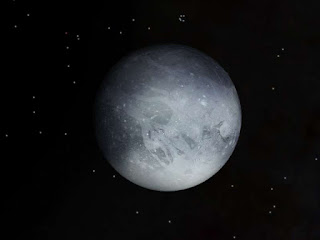"Following are some of the important things observed at Pluto by the New Horizons spacecraft. Note that these are early results and much more data will be received from the spacecraft in coming months.
---The ices on Pluto tend to sublimate (turn directly to gas), especially nitrogen and carbon monoxide. ---The gases may move across the surface, possibly in a seasonal manner. There may be nitrogen or organic snow. Since Pluto’s orbital period is 248 earth years, surface and gas processes probably vary over periods of several decades, as Pluto traverses its orbit. Hazes were observed by New Horizons at altitudes of approximately 120 km above Pluto.
---This puts hazes at a higher altitude than existing models support.
But much of the surface shows very few craters, which again implies geological activity or some resurfacing phenomena at work. In a region on the edge of the Kuiper belt with a number of small
objects in its vicinity including Pluto’s five known moons, Pluto was expected to possess more craters. Ice layers on the surface may also be moving.
If the solar system were created only several thousand years ago, atmospheric and geological processes could still be ‘active’ from creation. But over billions of years some processes essentially ‘run down’ and thus should not be still active. This approach may be applicable to Pluto." CMI
Hath in these last days spoken unto us by his Son, whom he hath appointed heir of all things, by whom also he made the worlds;
Hebrews 1:2
- Pluto is losing very large quantities of nitrogen into space. In a NASA Media Briefing on July 17, 2015 one of the researchers said an early estimate was that 500 tons of Nitrogen were escaping Pluto every hour.
- Pluto was found to be somewhat larger than previous estimates. Its diameter is now measured as 2,370 km. This means its density has been revised downward and it has more ice than previously thought.
- The surface has a variety of ‘zones’ of different characters. There are dark regions along its equator that have more craters, and yet much of the surface is covered with ice and possesses few craters.
- There are other mysterious structures on part of the surface thought to be mounds bounded by crevices. These are referred to by geologists as ‘polygonal features’.
- Pluto has mountain ranges. One of the ranges has been compared to earth’s Rocky mountains and another to the Appalachian mountains in height. These mountains are believed to be made of water ice.
- Charon (measured to be 1,208 km in diameter) also has an icy surface that is geologically interesting. It has large canyons and varied terrain.
---The ices on Pluto tend to sublimate (turn directly to gas), especially nitrogen and carbon monoxide. ---The gases may move across the surface, possibly in a seasonal manner. There may be nitrogen or organic snow. Since Pluto’s orbital period is 248 earth years, surface and gas processes probably vary over periods of several decades, as Pluto traverses its orbit. Hazes were observed by New Horizons at altitudes of approximately 120 km above Pluto.
---This puts hazes at a higher altitude than existing models support.
But much of the surface shows very few craters, which again implies geological activity or some resurfacing phenomena at work. In a region on the edge of the Kuiper belt with a number of small
objects in its vicinity including Pluto’s five known moons, Pluto was expected to possess more craters. Ice layers on the surface may also be moving.
If the solar system were created only several thousand years ago, atmospheric and geological processes could still be ‘active’ from creation. But over billions of years some processes essentially ‘run down’ and thus should not be still active. This approach may be applicable to Pluto." CMI
Hath in these last days spoken unto us by his Son, whom he hath appointed heir of all things, by whom also he made the worlds;
Hebrews 1:2


